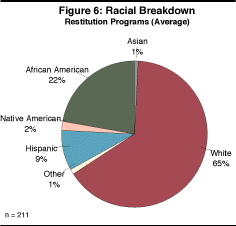|
Types of Offenders Table 9 shows that the average program surveyed in 1991 handled 1,130 offenders per year. This figure is swelled by the number of clients in programs that accept both juvenile and adult offenders, but in which most clients are adult (3,293). The average number of referrals per year to strictly juvenile programs and to programs for both juveniles and adults that accept mostly juveniles is almost identical (331 and 329, respectively). Solely adult programs also tend to be large, with an average of 1,919 clients per year. Previous surveys indicate that at least 70 percent of all restitution programs accept offenders who are diverted from formal judicial handling and therefore spared the threat of being convicted for a crime (Schneider and Warner, 1989). The current survey shows that most of the offenders referred to strictly juvenile programs are diverted, while most of the offenders referred to strictly adult programs are adjudicated. On the average, as shown in Table 10, the mean number of diverted and adjudicated offenders per program is just about equal (220.5 and 201.4, respectively). Across all types of programs, repeat offenders (those with one or more prior offenses) constitute about half of all adjudicated offenders. The racial composition of referrals to all responding programs is shown in Figure 6: the breakdown by race is roughly proportional to the representation of racial groups in the criminal and juvenile justice systems but, as is typical, disproportional to the racial composition of the population as a whole. 
|